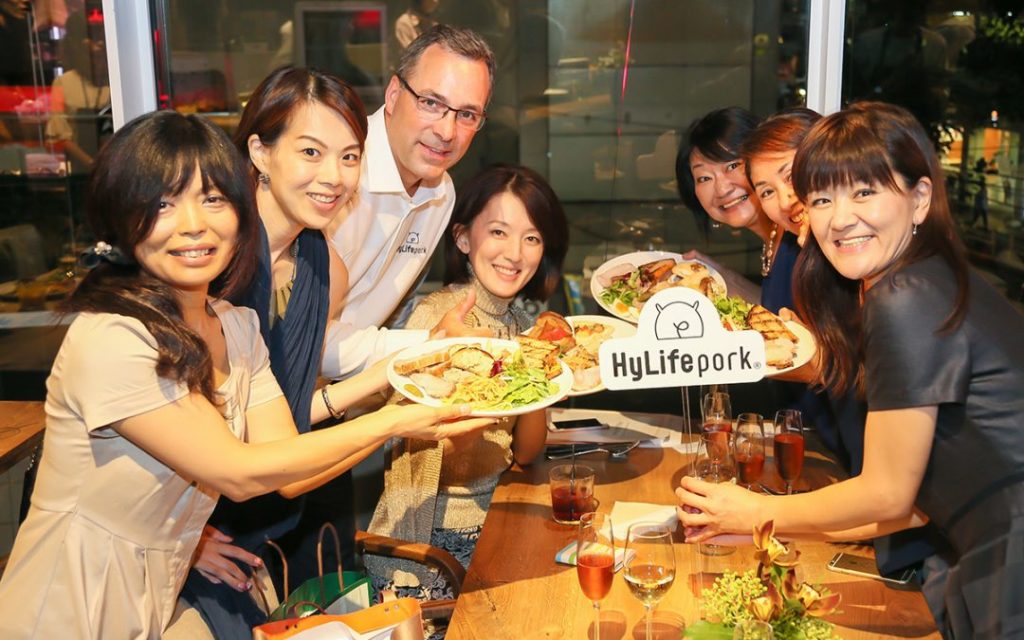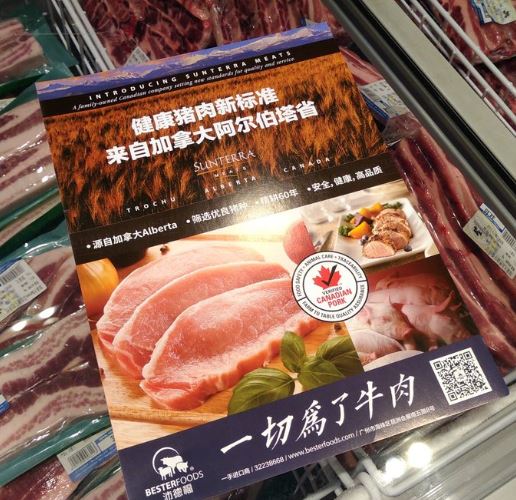By Andrew Heck
Relationships are crucial in business, and the pork business is no different. In many Asian societies, the importance of relationships is elevated even higher than other parts of the world. If you are doing business in Asia, like the Canadian pork industry, face-to-face interactions are priceless.
In November 2019, two separate Canadian pork delegations visited Japan and China with two separate yet similar goals of convincing buyers that they need our product. While the consumer needs and desires differ between the countries, the importance of these markets to our value chain cannot be overstated.
Canadian embassy in Tokyo full to the brim
More than 40 representatives of the Canadian pork industry visited Japan in early November 2019 to attend an event organized by Canada Pork International (CPI) at the Canadian embassy in Tokyo.
The representatives were on-hand to extol the virtues of Verified Canadian Pork, the consumer-facing brand for the Canadian Pork Excellence (CPE) quality assurance program, which is being implemented by many producers across the country as a value-added identify for premium Canadian products.
In 2018, Canada’s pork exports to Japan totalled $1.3 billion, making it our second-most value market, just behind the U.S. Japanese buyers have a great deal of respect for the Verified Canadian Pork brand and what it represents. In fact, CPI uses more than one million branded stickers every month to distinguish our pork in that country.
“Canadian producers can be proud to know just how appreciated their efforts are overseas,” said Neil Ketilson, Chair, CPI. “Japan’s culture for quality and detail is known around the world, and it’s a testament to the work our producers and processor’s do to ensure our product is the best in the world. The Japanese appreciate quality and consistency and the Canadian industry delivers to their specifications.”
The embassy event featured a news conference, information seminar and pork tasting reception to excite guests. Speeches and presentations were delivered by CPI and CPC officials. Reportedly, the embassy had never hosted an event of this magnitude and scale, with the crowd of eager Japanese buyers overflowing into the hallway outside the theatre where the event was hosted.
Touring Japan to gain a first-hand consumer perspective
Following the highly successful embassy event, some members of the delegation returned to Canada, while others stayed behind to embark on a series of tours highlighting the Japanese pork consumer market.
The first tour was scheduled to take place at Costco Japan—a major buyer of Canadian pork. Costco Japan is a wholly owned subsidiary of Costco U.S., with 26 locations in the country since expanding there in 1999. In contrast, Canada has 100 locations. The deal-breaker: Japan has more than three times as people as Canada and a higher proportion of its population as Costco members.

In Costco Japan’s meat coolers, Canadian products are featured distinctly from lesser-quality, lower-priced products, side-by-side, which speaks to the power of Canadian pork. The competitive sales levels, relative to Japan’s own domestic product, reinforces that understanding.
The second tour brought the delegation to HyLife Pork Table—a direct-to-consumer marketing concept that separates the company from many contemporaries in Canada. HyLife’s pork, raised mostly in Manitoba and Saskatchewan, is processed at the company’s plant in Neepawa, Manitoba, then shipped worldwide, with a strong emphasis on Japan. The Pork Table draws a direct line from the Canadian producer to the Japanese consumer, creating a narrative around the product that sets it apart in the market.

“Pork restaurants are unique in Japan. Generally, Japanese consumers think of pork as more of a daily food to be eaten at home. But actually, they recognize that things like pork steak and dry ribs are very attractive for them. We can also provide these meats at a reasonable price compared with something like beef,” said Nick Funakoshi, Chief Marketing Officer, HyLife Pork Asia. “We also serve Canadian maple syrup, ice wine, whisky and beer. As a business, HyLife Pork is constantly growing, and we now have customers from Hokkaido to Kyushu.”
African Swine Fever has China hungry for Canadian pork
Right on the heels of the Japan visit, a separate delegation of representatives from the CPC and Canadian Meat Council (CMC) made its way to several locations in China with strategic trans-Pacific shipping positioning: Tianjin (near Beijing), Shanghai, Shenzhen (near Hong Kong and Guangzhou).
The delegation went to China to make connections and talk about where improvements can be made, given some of the recent barriers to trade. The delegation had a goal to rectify any issues that could cause hurdles for Canadian pork’s entry into China in the future.
In June 2019, China banned all imports of Canadian pork products after the discovery of a fraudulent veterinarian’s certificate that indicated a product of supposedly Canadian origin contained ractopamine—a feed additive that is legal in many countries, including Canada, but banned in China.
More than four months following the declaration of the ban, just as the Canadian delegation had arrived in Japan, an announcement was made signalling that the ban in China had been lifted.
In 2018, Canada’s pork exports to China totalled $514 million, making it our third-most valuable market, just behind Japan. Sales in 2019 were on pace to double 2018 levels until the ban was put in place, which would have effectively placed the two countries neck-and-neck by dollar value to the Canadian pork industry.

When the ban was lifted, the news quickly spread, exciting Canadians, but concerning the Japanese, who are left to wonder if Canadian pork will now flow more slowly into their country, on account of China’s demand. Only time will tell, and it will be important for the Canadian industry to navigate these areas carefully to preserve the long-standing, treasured relationships we have, which has resulted in nearly half a century of uninterrupted trade. Neither the Canadian nor the Japanese take that lightly.
“Thanks to our special relationship with the Japanese, we have been able to flourish in the export business,” said Brent Moen, Chair, Alberta Pork. “The Japanese have always been exceptional customers, and our industry can’t ever lose sight of that. We look forward to increasing sales.”
While concerning for our partners in Japan, the lifting of the ban is very welcome by Chinese consumers, who have been hit with prices that have more than doubled since the ban was put in place, thanks to a similar restriction on U.S. meat imports and the loss of nearly half of China’s pig herd to African Swine Fever (ASF).

With the two recent Asian visits under its belt, the Canadian meat industry is feeling confident that critical trade relationships have been effectively fostered. As our industry continues moving in an export-based direction, this can only be a positive outcome during a time when the news has not always been so positive.





